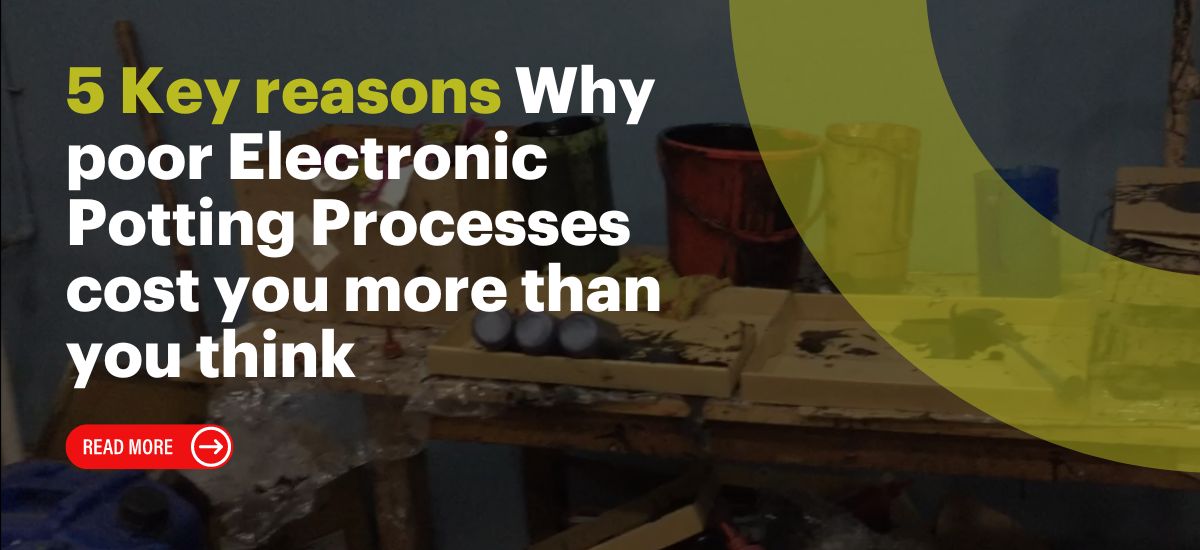Manual mixing and dispensing of epoxy or resins is still common in many potting applications such as Capacitors, Sensors, Relays, and various types of PCBs etc. To many manufacturers, manual mixing and dispensing appears to be a low-cost and convenient method. But in reality, it could be so only because the material wastage costs are hidden and mostly go unaccounted.
Twin Engineers recently conducted a survey of manufacturers of electronic components. The goal of the survey was to understand the patterns in material wastage when mixing of materials and potting is done manually. The results are quite shocking!
What surprised the Owners was how the the small number of wastage in every step in the end added to a huge percentage. Looking at the wastage patterns the realisation that manual mixing and dispensing costs much more than what they had initially assumed, stuck hard.
The survey found five key reasons why poor potting in electronic components leads to increased costs. The range of wastage as a percentage of total material changed with application. But surprisingly, the overall wastage seemed to be quite high for almost every applications relying on manual mixing and dispensing.
Rejection due to improper mix
The big wastage from small portions of overfilling (and under-filing)
When dispensed manually with a syringe, the chances of filling the job with more material than what is actually required are very high. For instance, when using a syringe to dispense 100 gms of mix in the job, it is not uncommon for workers to dispense 1-3 gms of extra mix. Add the extra mix for a couple of hundred components over the two shifts and the wastage becomes a significant proportion of the total material.
Many manufacturers perform two-stage potting. In this case, the first layer of mix is potted and allowed to settle for a while, before topping up with the second layer. Doing this manually, may invite even greater wastage due to overfilling.
Less filling also leads to material wastage. At times, it requires removal of the mix that is initially dispensed, cleaning and refill. In other cases, there is a natural tendency to fill a little more mix in the job, when the initial mix dispensed is less. A less skilled worker performing the potting will only add to the wastage. In both the cases, the lack of control over the accuracy of the shot size means rampant possibility of wastage.
The hidden costs due to spillage
Potting is an exothermic reaction. The reaction is in process even when the material is potted in the jobs. When potting manually, it is often difficult to accurately achieve the shot size. As a result, the material spills over from the job. Such material is often wiped off from the jobs by the workmen. While loss of material may be relatively less here, it still adds to the costs in terms of repeat work.
The unaccounted losses in PU/Epoxy handling
A lot of material wasted or lost when pouring from container to the mixing vessel. Inefficient handling during weighing also leads to wastage. The material that remains stuck inside the syringe units, mixing vessels also goes unaccounted. Although in small quantities, a lot of material ends up being wiped clean or just drops off from the syringe units between the dispensing shots. Again, the wastage that occurs in handling goes largely unaccounted. Worst still, it’s taken as a standard wastage norm of the process without any challenge.
The biggest cause of loss – ‘Leftover Mix’
The wastage of material that is lost as a leftover mix is absolutely hidden. Basically, with varying production schedules, the quantity of mix required in potting has to be calculated every time. The Resin and Hardner are available in standard packs. The mixing quantities are decided on rough, back of the envelope calculation by the workmen. Generally, there is a tendency to mix a batch for ‘little more’ than what is required to avoid for any shortfall at the last moment. Most of the times, this ‘little more’ ends up being a lot more than what was required in the batch.
The result is often, huge quantities of mixed materials lying unused (and also unaccounted) at the end of the shift. Given the short pot life, there is no option but to dispose-off this mixed material.
Among all the companies that we surveyed, it was common to be left with a significant quantity of leftover mix at the end of the shift. The lack of traceability meant the production staff and management had little control over this wastage.
How to switch to 100% accurate potting, and zero rejections?
The material wastage in mixing and dispensing could be as high as 20%, depending on the process and application. With the cost of materials ranging from Rs. 400/- per kg to Rs. 1,200/- per kg., the unnoticed costs of such wastage is detrimental to the profitability and cost competitiveness. For small and medium manufacturers, who typically work on thinner margins and higher volumes, reducing the wastage will have a direct impact on the bottom line.
Manufacturers using Twin’s mixing and dispensing machines have reported the payback in a year’s time with 100% accurate potting, zero rejections and material wastage.

